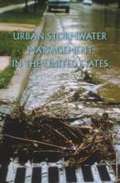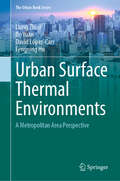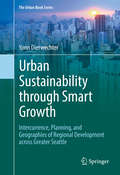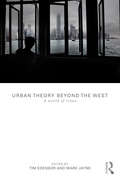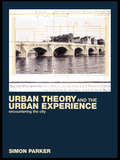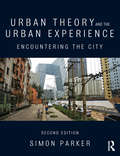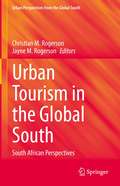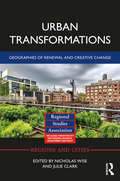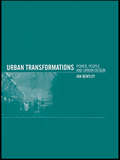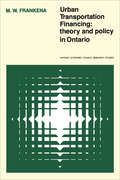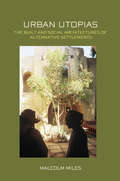- Table View
- List View
Urban Stormwater Management In The United States
by National Research Council of the National AcademiesThe rapid conversion of land to urban and suburban areas has profoundly altered how water flows during and following storm events, putting higher volumes of water and more pollutants into the nation's rivers, lakes, and estuaries. These changes have degraded water quality and habitat in virtually every urban stream system. The Clean Water Act regulatory framework for addressing sewage and industrial wastes is not well suited to the more difficult problem of stormwater discharges. This book calls for an entirely new permitting structure that would put authority and accountability for stormwater discharges at the municipal level. A number of additional actions, such as conserving natural areas, reducing hard surface cover (e.g., roads and parking lots), and retrofitting urban areas with features that hold and treat stormwater, are recommended.
Urban Stormwater and Flood Management: Enhancing the Liveability of Cities (Applied Environmental Science and Engineering for a Sustainable Future)
by Geoffrey Parker Ashantha Goonetilleke Veeriah Jegatheesan John Van Leeuwen Jaya Kandasamy Doug Warner Baden Myers Muhammed Bhuiyan Kevin SpenceThis book brings together the experiences of engineers and scientists from Australia and the United Kingdom providing the current status on the management of stormwater and flooding in urban areas and suggesting ways forward. It forms a basis for the development of a framework for the implementation of integrated and optimised storm water management strategies and aims to mitigate the adverse impacts of the expanding urban water footprint. Among other topics it also features management styles of stormwater and flooding and describes biodiversity and ecosystem services in relation to the management of stormwater and the mitigation of floods. Furthermore, it places an emphasis on sustainable storm water management measures. Population growth, urbanisation and climate change will pose significant challenges to engineers, scientists, medical practitioners, policy makers and practitioners of several other disciplines. If we consider environmental and water engineers, they will have to face challenges in designing smart and efficient water systems which are robust and resilient to overcome shrinking green spaces, increased urban heat islands, damages to natural waterways due to flooding caused by increased stormwater flow. This work provides valuable information for practitioners and students at both senior undergraduate and postgraduate levels.
Urban Street Stormwater Guide
by National Association of City Transportation OfficialsThe Urban Street Stormwater Guide begins from the principle that street design can support—or degrade—the urban area's overall environmental health. By incorporating Green Stormwater Infrastructure (GSI) into the right-of-way, cities can manage stormwater and reap the public health, environmental, and aesthetic benefits of street trees, planters, and greenery in the public realm.Building on the successful NACTO urban street guides, the Urban Street Stormwater Guide provides the best practices for the design of GSI along transportation corridors.The state-of-the-art solutions in this guide will assist urban planners and designers, transportation engineers, city officials, ecologists, public works officials, and others interested in the role of the built urban landscape in protecting the climate, water quality, and natural environment.
Urban Structure Matters: Residential Location, Car Dependence and Travel Behaviour (RTPI Library Series)
by Petter NaessGoing beyond previous investigations into urban land use and travel, Petter Næss presents new research from Denmark on residential location and travel to show how and why urban spatial structures affect people's travel behaviour. In a comprehensive case study of the Copenhagen metropolitan area, Næss combines traditional quantitative travel surveys with qualitative interviews in order to identify the more detailed mechanisms through which urban structure affects travel behaviour. The case study findings are compared with those from other Nordic countries and analyzed and evaluated in the light of relevant theory and literature to provide solid, valuable conclusions for planning sustainable urban development. With a broader range of statistics than previous studies and conclusions of international relevance, Urban Structure Matters provides well-grounded conclusions for how spatial planning of urban areas can be used to reduce car dependence and achieve a more sustainable development of cities.
Urban Subversion and the Creative City (Routledge Critical Studies in Urbanism and the City)
by Oli MouldCheck out the author's video to find out more about the book: https://vimeo.com/124247409 This book provides a comprehensive critique of the current Creative City paradigm, with a capital ‘C’, and argues for a creative city with a small ‘c’ via a theoretical exploration of urban subversion. The book argues that the Creative City (with a capital 'C') is a systemic requirement of neoliberal capitalist urban development and part of the wider policy framework of ‘creativity’ that includes the creative industries and the creative class, and also has inequalities and injustices in-built. The book argues that the Creative City does stimulate creativity, but through a reaction to it, not as part of it. Creative City policies speak of having mechanisms to stimulate individual, collective or civic creativity, yet through a theoretical exploration of urban subversion, the book argues that to be 'truly' creative is to be radically different from those creative practices that the Creative City caters for. Moreover, the book analyses the role that urban subversion and subcultures have in the contemporary city in challenging the dominant political economic hegemony of urban creativity. Creative activities of people from cities all over the world are discussed and critically analysed to highlight how urban creativity has become co-opted for political and economic goals, but through a radical reconceptualisation of what creativity is that includes urban subversion, we can begin to realise a creative city (with a small 'c').
Urban Surface Thermal Environments: A Metropolitan Area Perspective (The Urban Book Series)
by Liang Zhou Bo Yuan David López-Carr Fengning HuUrban Surface Thermal Environments: A Metropolitan Area Perspective presents a comprehensive exploration of urban heat dynamics through the perspectives of climate change, urbanization, green infrastructure, and two- and three-dimensional urban morphology. It analyzes the key drivers of surface urban heat islands (SUHI), reveals spatial and temporal patterns of warming, assesses population heat risks, and proposes practical strategies to mitigate thermal impacts. Incorporating spatial analysis, multi-source data integration, and urban-scale simulation, the book provides effective solutions for megacities worldwide under increasing heat stress—supporting adaptive governance, enhancing livability, and advancing SDG 11. The book presents a series of analytical frameworks designed to capture thermal heterogeneity, identify vulnerable populations, and inform intervention strategies across scales—from site-specific cooling measures to integrated regional spatial planning. By bridging climate science, urban design, and geospatial technologies, it offers actionable approaches to enhance urban resilience and guide climate adaptation efforts. This integrated framework aligns with the Paris Agreement, including the 1.5°C climate target, and is informed by recent scientific assessments from IPCC, offering spatially explicit support for evidence-based decision-making. As a valuable reference for researchers, urban planners, environmental professionals, policymakers, and graduate students, this book informs decisions in the fields of climate adaptation, sustainable urban development, and spatial planning. It contributes to key global and national initiatives, including SDG11 and SDG13, Future Earth, and China&’s new urbanization strategy. Through its interdisciplinary and geography-informed perspective, the book enhances cities&’ adaptive capacity and contributes to the development of cooler, more equitable, and climate-resilient human settlements in an era of global warming.
Urban Sustainability Transitions: European And Asian Experiences (Routledge Studies in Sustainability Transitions)
by Derk Loorbach Vanesa Castán Broto Niki Frantzeskaki Lars CoenenThe world’s population is currently undergoing a significant transition towards urbanisation, with the UN expecting that 70% of people globally will live in cities by 2050. Urbanisation has multiple political, cultural, environmental and economic dimensions that profoundly influence social development and innovation. This fundamental long-term transformation will involve the realignment of urban society’s technologies and infrastructures, culture and lifestyles, as well as governance and institutional frameworks. Such structural systemic realignments can be referred to as urban sustainability transitions: fundamental and structural changes in urban systems through which persistent societal challenges are addressed, such as shifts towards urban farming, renewable decentralised energy systems, and social economies. This book provides new insights into how sustainability transitions unfold in different types of cities across the world and explores possible strategies for governing urban transitions, emphasising the co-evolution of material and institutional transformations in socio-technical and socio-ecological systems. With case studies of mega-cities such as Seoul, Tokyo, New York and Adelaide, medium-sized cities such as Copenhagen, Cape Town and Portland, and nonmetropolitan cities such as Freiburg, Ghent and Brighton, the book provides an opportunity to reflect upon the comparability and transferability of theoretical/conceptual constructs and governance approaches across geographical contexts. Urban Sustainability Transitions is key reading for students and scholars working in Environmental Sciences, Geography, Urban Studies, Urban Policy and Planning.
Urban Sustainability and River Restoration: Green and Blue Infrastructure
by Katia Perini Paola SabbionUrban Sustainability and River Restoration: Green and Blue Infrastructure considers the integration of green and blue infrastructure in cities as a strategy useful for acting on causes and effects of environmental and ecological issues. River restoration projects are unique opportunities for sustainable development and smart growth of communities, providing multiple environmental, economic, and social benefits.This book analyzes initiatives and actions carried out and developed to improve environmental conditions in cities and better understand the environmental impact of (and in) dense urban areas in the United States and in Europe.
Urban Sustainability in Theory and Practice: Circles of sustainability (Advances in Urban Sustainability)
by Paul JamesCities are home to the most consequential current attempts at human adaptation and they provide one possible focus for the flourishing of life on this planet. However, for this to be realized in more than an ad hoc way, a substantial rethinking of current approaches and practices needs to occur. Urban Sustainability in Theory and Practice responds to the crises of sustainability in the world today by going back to basics. It makes four major contributions to thinking about and acting upon cities. It provides a means of reflexivity learning about urban sustainability in the process of working practically for positive social development and projected change. It challenges the usually taken-for-granted nature of sustainability practices while providing tools for modifying those practices. It emphasizes the necessity of a holistic and integrated understanding of urban life. Finally it rewrites existing dominant understandings of the social whole such as the triple-bottom line approach that reduce environmental questions to externalities and social questions to background issues. The book is a much-needed practical and conceptual guide for rethinking urban engagement. Covering the full range of sustainability domains and bridging discourses aimed at academics and practitioners, this is an essential read for all those studying, researching and working in urban geography, sustainability assessment, urban planning, urban sociology and politics, sustainable development and environmental studies.
Urban Sustainability in the Arctic: Measuring Progress in Circumpolar Cities (Studies in the Circumpolar North #3)
by Robert W. OrttungUrban Sustainability in the Arctic advances our understanding of cities in the far north by applying elements of the international standard for urban sustainability (ISO 37120) to numerous Arctic cities. In delivering rich material about northern cities in Alaska, Canada, and Russia, the book examines how well the ISO 37120 measures sustainability and how well it applies in northern conditions. In doing so, it links the Arctic cities into a broader conversation about urban sustainability more generally.
Urban Sustainability through Smart Growth
by Yonn DierwechterThis book investigates the new urban geographies of "smart" metropolitan regionalism across the Greater Seattle area and examines the relationship between smart growth planning strategies and spaces of work, home, and mobility. The book specifically explores Seattle within the wider space-economy and multi-scaled policy regime of the Puget Sound region as a whole, 'jumping up' from questions of city politics to concerns with what the book interprets as the "intercurrence" of city-regional "ordering. " These theoretical terms capture the state-progressive effort to promote smarter forms of regional development but also the societal/institutional tensions and outright contradictions that such urban development invariably entails, particularly around problems of social equity. Key organizing themes in the text include: the historical path-dependencies of uneven economic and social development, particularly between Tacoma-Pierce County and Seattle-King County; current patterns of high-wage, medium-wage, and low-wage jobs; the emerging spatial and social structure of recent residential changes, especially with respect to class and race composition; and, finally, transit trends and new urban spaces associated with policy efforts to mitigate highway congestion and car-dependency. Greater Seattle, then, is mapped as a key US urban region inscribed spatially by the uneven search for a more sustainable order. Historically-sensitive, theoretically-informed and empirically topical, this book is of interest to scholars and students at all levels in regional planning, urban geography, political science, sustainability studies, urban sociology and public policy.
Urban Sustainability: A Game-Based Approach (Springer Texts in Business and Economics)
by Jason Papathanasiou Georgios Tsaples Anastasia BlouchoutziThis textbook provides an innovative pedagogy to students who will be the policy makers of tomorrow. It provides thoughts on sustainability and the complexity among its different dimensions. It guides students through experience, processes of complex decision making, and sharpen their clarity of thought, to enhance their communication abilities and help them develop critical thinking. It provides key competencies to address the complexities of sustainable development.By combining game-based learning with an analytical style of education, supplemental materials are provided to make the definitions of various sustainability aspects more concrete and allows students to experiment in a consequence-free environment, with scenario examples. Board Game and a hypothetical management course, dealing with various topics like transportation sustainability, societal metabolism, etc. as well as with decision making under those contexts, will formalize the mathematics needed to make robust decisions.
Urban Sustainability: Navigating Environmental Transition Challenges in Global South (Disaster Risk Reduction)
by Rajib Shaw Mohammed Firoz C Lalit Kumar DashoraThis book delves into the dynamic intersection of urbanization and sustainability in the rapidly evolving cities of the Global South and unravels the complexities and nuances surrounding the environmental transition challenges in the region. The primary objective is to offer a comprehensive understanding of how cities in the Global South are struggling with the intricate task of achieving sustainability amidst rapid urbanization with population growth, economic transformations, and environmental uncertainties such as climate change associated with emerging extreme events. By examining case studies, policy frameworks, and innovative solutions, the book sheds light on the unique circumstances shaping the sustainability discourse in these urban landscapes. The book also provides a roadmap to craft-informed policies and strategies to foster sustainable urban development, addressing pressing issues such as resource management, climate resilience, and social equity. As the cities of the Global South navigate the challenges of the twenty-first century, the "urban sustainability" emerges as a timely and indispensable guide to shape resilient, inclusive, and environmentally conscious cities in the Global South. This book is a valuable resource for academics, policymakers, urban planners, environmentalists, and citizens at large.
Urban Sustainability: Policy and Praxis
by Ryan R. Jensen Jay D. Gatrell Mark W. Patterson Nancy Hoalst-PullenThis book explores the environmental, economic, and socio-political dynamics of sustainability from a geographic perspective. The chapters unite the often disparate worlds of environment, economics, and politics by seeking to understand and visualize a range of sustainability practices on the ground and in place. In concert, the book provides an overview of a range of geotechnical applications associated with environmental change (water resources, land use & land cover change); as well as investigates more nuanced and novel examples of local economic development in cities. The diverse collection maps local practices from urban farming to evolving and thriving industries such as metal scrapping and craft beer. Additionally, the book provides an integrated geo-technical framework for understanding and assessing ecosystem services, explores the deployment of unmanned systems to understand urban environmental change, interrogates the spatial politics of urban green movements, examines the implications of revised planning practices, and investigates environmental justice. The book will be of interest to researchers, students, and anyone seeking to better understand sustainability at multiple scales in urban environments.
Urban Theory Beyond the West: A World of Cities
by Tim Edensor Mark JayneSince the late eighteenth century, academic engagement with political, economic, social, cultural and spatial changes in our cities has been dominated by theoretical frameworks crafted with reference to just a small number of cities. This book offers an important antidote to the continuing focus of urban studies on cities in ‘the Global North’. Urban Theory Beyond the West contains twenty chapters from leading scholars, raising important theoretical issues about cities throughout the world. Past and current conceptual developments are reviewed and organized into four parts: ‘De-centring the City’ offers critical perspectives on re-imagining urban theoretical debates through consideration of the diversity and heterogeneity of city life; ‘Order/Disorder’ focuses on the political, physical and everyday ways in which cities are regulated and used in ways that confound this ordering; ‘Mobilities’ explores the movements of people, ideas and policy in cities and between them and ‘Imaginaries’ investigates how urbanity is differently perceived and experienced. There are three kinds of chapters published in this volume: theories generated about urbanity ‘beyond the West’; critiques, reworking or refining of ‘Western’ urban theory based upon conceptual reflection about cities from around the world and hybrid approaches that develop both of these perspectives. Urban Theory Beyond the West offers a critical and accessible review of theoretical developments, providing an original and groundbreaking contribution to urban theory. It is essential reading for students and practitioners interested in urban studies, development studies and geography.
Urban Theory and the Urban Experience: Encountering the City
by Simon ParkerFor the first time Urban Theory and the Urban Experience brings together classic and contemporary approaches to urban research in order to reveal the intellectual origins of urban studies, and the often unacknowledged debt that empirical and theoretical perspectives on the city owe to one another. Both students and urban scholars will appreciate the critical way in which classical and contemporary debates on the nature of the city are presented. Extensive use is made throughout of documentary, literary and cultural sources to bring the different theoretical perspectives to life. Discussion points introduce and explain key concepts and intellectual histories in a jargon free manner. End of chapter further readings have also been annotated to encourage additional study.
Urban Theory and the Urban Experience: Encountering the City
by Simon ParkerUrban Theory and the Urban Experience brings together classic and contemporary approaches to urban research in order to reveal the intellectual origins of urban studies and the often unacknowledged debt that empirical and theoretical perspectives on the city owe one another. From the foundations of modern urban theory in the work of Weber, Simmel, Benjamin and Lefebbvre to the writings of contemporary urban theorists such as David Harvey and Manuel Castells and the Los Angeles school of urbanism, Urban Theory and the Urban Experience traces the key developments in the idea of the city over more than a century. Individual chapters explore investigative studies of the great metropolis from Charles Booth to the contemporary urban research of William J. Wilson, along with alternative approaches to the industrial city, ranging from the Garden City Movement to ‘the new urbanism’. The volume also considers the impact of new information and communication technologies, and the growing trend towards disaggregated urban networks, all of which raise important questions about viability and physical and social identity of the conventional townscape. Urban Theory and the Urban Experience concludes with a rallying cry for a more holistic and integrated approach to the urban question in theory and in practice if the rich potent. For the benefit of students and tutors, frequent question points encourage exploration of key themes, and annotated further readings provide follow-up sources for the issues raised in each chapter. The book will be of interest to students, scholars, practitioners and all those who wish to learn more about why the urban has become the dominant social, economic and cultural form of the twenty-first century
Urban Tourism and Development in the Socialist State: Havana during the �pecial Period (New Directions In Tourism Analysis Ser.)
by Andrea ColantonioAfter the collapse of the Soviet bloc in 1989, Fidel Castro announced the beginning of aSpecial Period for Cuba. During this time, the Cuban government has been obliged to look outward to other economies of the developed world, specifically targeting tourism as a mechanism for economic growth and development. This book examines the role played by international tourism in Cuba‘s institutional and economic restructuring and the country‘s reinsertion into the capitalist world economy. It provides the most comprehensive, in-depth analysis of the economic, social, environmental and political realities which have emerged in Cuba as a result of the redevelopment of urban tourism since the early 1990s. By analyzing the allocation of tourist resources and its impacts, the generation of tourism policy, and the politics of tourism development, it focuses on the political economy of urban tourism in Cuba and the balance of power between domestic and foreign stakeholders involved in the Cuban tourist industry.
Urban Tourism in the Global South: South African Perspectives (GeoJournal Library)
by Christian M. Rogerson Jayne M. RogersonThis book examines and addresses the particular character of urban tourism occurring in the global South. It presents research essays on tourism in urban areas of South Africa, a country which is associated with big 5 nature tourism but where urban areas are also major tourism destinations. The book contextualizes urban tourism in South Africa as part of ‘the other half of urban tourism’, an overlooked but energetic scholarship which is emerging on urban places in the global South. The volume moves to present a collection of original material variously on national perspectives on urban tourism following by a cluster of city level perspectives. The last three contributions turn to the role of tourism in small towns, the bottom rung in the urban settlement system. Issues of concern include gastronomic tourism, VFR travel, airportscapes, climate change, AirBnb and creative tourism. Finally, as COVID-19 is potentially a defining historical moment for urban tourism, the volume incorporates historical research perspectives in order to address the overwhelming ‘present-mindedness’ of mainstream urban tourism writings. The book highlights the challenges and opportunities for tourism development in the environment of the urban global South and is relevant to scholars of both tourism and urban studies as well as researchers in development studies.
Urban Transformational Landscapes in the City-Hinterlands of Asia: Challenges and Approaches (Advances in 21st Century Human Settlements)
by George M. Pomeroy Debnath Mookherjee Le Thi Thu HuongIn the context of mounting challenges stemming from a rapid transformation of the urban-regional landscapes in many Asian countries, this book highlights a multifaceted array of issues that increasingly engage the academic and planning communities in search of viable solutions to complex problems facing us. Even though cities continue to dominate development studies, urbanization of Asia is evolving toward a hybrid urban-rural nexus beyond the cities. This volume considers these shifting dynamics of Asian urbanization, including urban spatial transformations and their ramifications in the context of sustainability and planning. Through the lens of a set of empirical studies across diverse disciplines, geographies and methodologies. yet with an overarching concern for sustainability in varied (but interconnected) areas such as climate change, land use planning, infrastructure and urban mobility, and quality of life, these studies examine a range of important topics (e.g., flooding, transportation, housing, open space/ green space, urban garden and such) in city/regional settings. Together, they add insights into varied transformational processes or patterns at work on the urban-regional landscapes in a number of Asian countries while offering innovative approaches or alternatives. The proposed volume fills a gap in urban/regional studies in context of South and Southeast Asia that will be of interest to all stakeholders (e.g., planners, administrators, academicians and the citizenry), particularly those interested in sustainability and planning paradigms. It should be a timely and valuable addition to the Asian urbanization literature.
Urban Transformations: Geographies of Renewal and Creative Change (Regions and Cities)
by Julie Clark Nicholas WiseEconomic restructuring and demographic change have in recent years placed much strain on urban areas with the effects falling disproportionately on neighbourhoods that were previously underpinned by industry and manufacturing. This has presented policy makers and city planners with a binary choice: to resist change and stagnate or to change and attempt to keep up with the pace of global demand. This edited book tells the story of how urban transformation impacts on people’s lives and everyday interactions – to question where and to whom benefit accrues from these changes. Urban Transformations offers insight into both risk and reward as local communities and public authorities creatively address the challenge of building vital and sustainable urban environments. The authors in this edited collection argue that understanding the specifics of community, space and place is crucial to delivering insights into how, where, when, why and for whom urban areas might successfully transform. The chapters investigate urban change using a range of approaches, and case studies from the four corners of the Earth – from the United States to Iran; from the United Kingdom to Canada. The varying scales at which governance or regeneration initiatives operate, the nature and composition of urban communities, and the local or global interests of different private sector actors all raise questions for urban policy and practice. It is important to not only consider the drivers of regeneration, but its beneficiaries need to be identified. This edited volume addresses and elaborates on critical issues facing urban transformation and renewal as a basis for future discussion on strategies for ‘successful’ urban transformation.
Urban Transformations: Power, People and Urban Design
by Ian BentleyCities affect every person's life, yet across the traditional divides of class, age, gender and political affiliation, armies of people are united in their dislike of the transformations that cities have undergone in recent times. The physical form of the urban environment is not a designer add-on to 'real' social issues; it is a central aspect of the social world. Yet in many people's experience, the cumulative impacts of recent urban development have created widely un-loved urban places. To work towards better-loved urban environments, we need to understand how current problems have arisen and identify practical action to address them.Urban Transformations examines the crucial issues relating to how cities are formed, how people use these urban environments and how cities can be transformed into better places. Exploring the links between the concrete physicality of the built environment and the complex social, economic, political and cultural processes through which the physical urban form is produced and consumed, Ian Bentley proposes a framework of ideas to provoke and develop current debate and new forms of practice.
Urban Transport Planning: Theory and Practice (Routledge Library Editions: Urban Planning #4)
by John BlackOriginally published in 1981, Urban Transport Planning explains how the systems approach has been applied in the planning of multi-modal transport planning and to demonstrate how a city may be represented by land use zones superimposed with a transport network. It discusses theoretical developments and demonstrates their application to practical problems of planning by using actual case studies. By treating the urban area as a system, and recognising the fundamental interactions between land use, traffic and transport, the study shows how it is possible to predict the future demands for travel, how transport requirements are determined and how alternative plans are formulated and evaluated.
Urban Transportation Financing: Theory and Policy in Ontario
by Mark W. FrankenaThis is an economic analysis of pricing and subsidy policies for urban roads and urban public transit in Ontario. Professor Frankena demonstrates the benefits of evaluating the economic merits of policy alternatives, and attempts to determine whether existing policies waste resources or lead to undesirable income transfers among different groups in the population. He concludes that resources are being wasted because the use of urban roads is substantially underpriced during periods of peak demand. He also finds that while there are sound economic justifications for substantial public transit subsidies, the allocation of subsidies by the Ontario government on the basis of capital expenditures can be expected to waste resources, as can the maximization of ridership which is likely to lead to detrimental fare and service policies. In conclusion, Frankena suggests improvements in the systems for charging people for the use of roads and public transit and in the ways that governments provide subsidies.
Urban Utopias: The Built and Social Architectures of Alternative Settlements
by Malcolm MilesUtopia tends to generate a bad press - regarded as impracticable, perhaps nostalgic, or contradictory when visions of a perfect world cannot accommodate the change that is necessary to a free and self-organizing society. But people from diverse backgrounds are currently building a new society within the old, balancing literal and metaphorical utopianism, and demonstrating plural possibilities for alternative futures and types of settlement. Thousands of such places exist around the world, including intentional communities, eco-villages, permaculture plots, religious and secular retreats, co-housing projects, self-build schemes, projects for low-impact housing, and activist squats in urban and rural sites. This experience suggests, however, that when planning and design are not integral to alternative social formations, the modern dream to engineer a new society cannot be realized. The book is structured in four parts. In part one, literary and theoretical utopias from the early modern period to the nineteenth-century are reconsidered. Part two investigates twentieth-century urban utopianism and contemporary alternative settlements focusing on social and environmental issues, activism and eco-village living. Part three looks to wider horizons in recent practices in the non-affluent world, and Part four reviews a range of cases from the author’s visits to specific sites. This is followed by a short conclusion in which a discussion of key issues is resumed. This book brings together insights from literary, theoretical and practical utopias, drawing out the characteristics of groups and places that are part of a new society. It links today’s utopian experiments to historical and literary utopias, and to theoretical problems in utopian thought.
